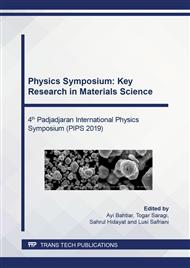[1]
D. Anggoro, Endarko, Evaluating capacitive deionization for measurements of the salt-removal of NaCl, KCl and MgCl at various cell voltages, Adv. Mat. Res. 1112 (2015) 271–274.
DOI: 10.4028/www.scientific.net/amr.1112.271
Google Scholar
[2]
R. Zhao, O. Satpradit, H.H.M. Rijnaarts, P.M. Biesheuvel, A. van der Wal, Optimization of salt adsorption rate in membrane capacitive deionization, Water Research. 47 (2013) 1941–(1952).
DOI: 10.1016/j.watres.2013.01.025
Google Scholar
[3]
S.-M. Jung, J.-H. Choi, J.-H. Kim, Application of capacitive deionization (CDI) technology to insulin purification process, Sep. Purif. Technol. 98 (2012) 31–35.
DOI: 10.1016/j.seppur.2012.06.005
Google Scholar
[4]
D. Anggoro, M. Saefuddin, I. Fatimah, S. Indrawati, Sudarsono, Nurrisma, Optimization of high temperature furnace system as one of the spray pyrolisis subsystems based on R type thermocouples and PID control, J. Phys.: Conf. Ser. 1153 (2019) 012037.
DOI: 10.1088/1742-6596/1153/1/012037
Google Scholar
[5]
G. Wang, C. Pan, L. Wang, Q. Dong, C. Yu, Z. Zhao, J. Qiu, Activated carbon nanofibers webs made by electrospinning for capacitive deionization, Electrochim. Acta. 69 (2012) 65–70.
DOI: 10.1016/j.electacta.2012.02.066
Google Scholar
[6]
B.-H. Park, Y.-J. Kim, J.-S. Park, J. Choi, Capacitive deionization using a carbon electrode prepared with water-soluble poly(vinyl alcohol) binder, J. Ind. Eng. Chem. 17 (2011) 717–722.
DOI: 10.1016/j.jiec.2011.05.015
Google Scholar
[7]
Z.-H. Huang, Z. Yang, F. Kang, M. Inagaki, Carbon electrodes for capacitive deionization, J. Mater. Chem. A 5 (2017) 470–496.
DOI: 10.1039/c6ta06733f
Google Scholar
[8]
A.G. El-Deen, N.A.M. Barakat, K.A. Khalil, H.Y. Kim, Hollow carbon nanofibers as an effective electrode for brackish water desalination using the capacitive deionization process, New J. Chem. 38 (2014) 198–205.
DOI: 10.1039/c3nj00576c
Google Scholar
[9]
N.A.M. Barakat, A.G. El-Deen, K.A. Khalil, Effective modified carbon nanofibers as electrodes for capacitive deionization process, J. Chem. Eng. Mater. Sci. 02 (2014) 38–42.
DOI: 10.4236/msce.2014.21007
Google Scholar
[10]
G. Yudoyono, Sudarsono, D. Anggoro, Preparation and characterization of electrospun composite fiber of polymer-TiO2, Mater. Sci. Forum 966 (2019) 60–65.
DOI: 10.4028/www.scientific.net/msf.966.60
Google Scholar
[11]
Y. Bian, P. Liang, X. Yang, Y. Jiang, C. Zhang, X. Huang, Using activated carbon fiber separators to enhance the desalination rate of membrane capacitive deionization, Desalination 381 (2016) 95–99.
DOI: 10.1016/j.desal.2015.11.016
Google Scholar
[12]
Endarko, N. Fadilah, D. Anggoro, Carbon electrode for desalination purpose in capacitive deionization, AIP Conf. Proc. 1719 (2016) 030026.
DOI: 10.1063/1.4943721
Google Scholar
[13]
C. Panatarani, D. Anggoro, I.M. Joni, Rare earth doped on LaPO4 nanocrystal, AIP Conf. Proc. 1454 (2012) 227.
DOI: 10.1063/1.4730727
Google Scholar


